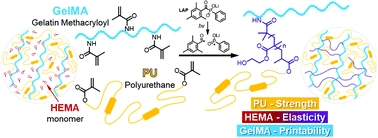Polyurethane–gelatin methacryloyl hybrid ink for 3D printing of biocompatible and tough vascular networks†
Abstract
A polyurethane–gelatin methacryloyl (PU–GelMA) hybrid ink was developed as a photo-crosslinkable elastic hydrogel. With the additional acrylic monomer, the ink can be tuned to accommodate elasticity and printability. Attributed to the shear-thinning properties of GelMA, PU–GelMA was preferable for extrusion printing. 3D-constructs were printed by direct extrusion or by using a sacrificial scaffold to resemble the vascular networks. The proliferation of endothelial cells on the PU–GelMA hydrogel indicated decent biocompatibility and potential utilization in artificial vessels.

- This article is part of the themed collection: Celebrating 10 years of ChemComm Emerging Investigators


 Please wait while we load your content...
Please wait while we load your content...